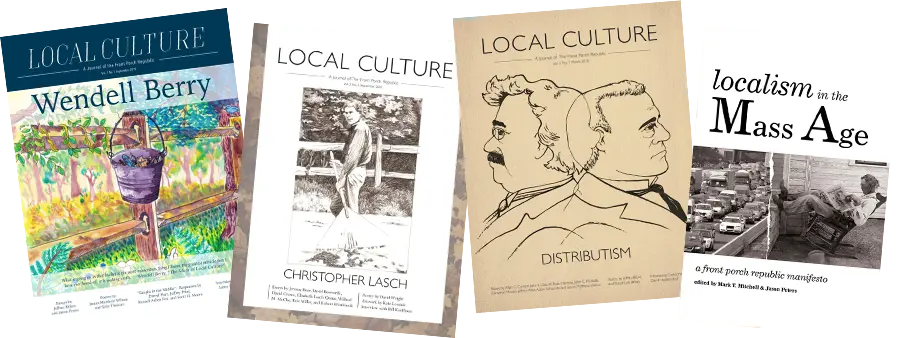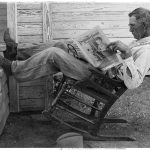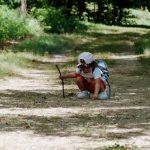The summer of 1922 ended with an ambitious hike on the Long Trail, beginning in Bennington and following the Green Mountains northward to the Canadian border [a] 225 mile trek…they carried on their backs all their supplies…Frost kept a small notebook in his pocket.
Jay Parini, Robert Frost: A Life
One of my favorite Gary Larsen cartoons features a split panel. At the top, people are entering the pearly gates, greeted by an angel who says, “Welcome to heaven. Here’s your harp.” At the bottom, people are queued up at the gates of hell, where a devil greets them saying, “Welcome to hell. Here’s your accordion.”
I think it should be policy, whenever we lead someone to faith in Jesus, that our first words after the prayer of confession and commitment should be, “Welcome to the Kingdom of God. Here’s your Bible, and here’s your notebook.”
Few matters of faith are more important than, by careful and continuous attention, learning to discern, experience, and respond to the grace and glory of God. And few resources are more valuable for practicing that discipline than the humble notebook—preferably pocket-size. Many—perhaps most—of us pay scant attention to what God is revealing of Himself all around (Prov. 25.2). By being more attentive and searching out the grace and glory of the Lord, our experience of His Presence and our gratitude, praise, and delight in Him will deepen.
And here is where a notebook can help. It may be surprising to think that a notebook—or a collection of notebooks—could help us pay more attention to our surroundings, but it’s true, as I’m sure many readers have already discovered.
I have kept notebooks on my reading and study of Scripture for over fifty years. The thousands of notes in these notebooks have been of incalculable value, not only for my growth in faith but also as resources for preaching, teaching, and writing.
But here I am more concerned about other sorts of notebooks. Hopkins first made me aware of the value of journaling on more everyday matters. The Penguin edition of his works provides excerpts from his journal in which Hopkins remarked and reflected on his surroundings, the weather, activities, topics of study, aspects of creation, travels, and the people he met. Many of these excerpts seem like diaries, but they are more than that. The notes comprise a palette from which Hopkins drew ideas for poems. You can see that in the way his entries include visual, tactile, and aural observations—the essence of much of Hopkins’ verse. He seems almost to be pondering the “inscape” of his surroundings in an entry like this, during a trip to Basel, for July 6, 1866:
But Basel at night! with a full moon waking the river and sending up straight beams from the heavy clouds that overhung it… We went through great spacious streets and places dead still and came to fountains of the clearest black water through which pieces of things at the bottom gleamed white.
Or this, from March 12, 1870:
A fine sunset: the higher sky dead clear blue bridged by a broad slant causeway rising from right to left of wisped grass cloud, the wisps lying across; the sundown yellow, mostly with light but ending at the top in a foam of delicate white pearling and spotted with big tufts of cloud in colour russet between brown and purple edged with brassy light.
We cannot fail to see here the mind of a poet at work (“spacious streets and places” or “bridged by a broad” or “brown and purple edged with brassy light”).
Le Corbusier also was fanatical about notebooks, as William H. Jordy explained in a 1983 article in The New Criterion: “A suitcase found in a closet in Le Corbusier’s Paris apartment at 24 rue Nungesser-et-Coli after his death contained seventy-three sketchbooks neatly ordered. They include a mélange of sketches and notes: on designs in progress (not only for architecture, but for paintings and sculpture as well), travel observations, rough drafts or outlines for writings or talks, diagrammatic plans for exhibitions, vituperations against those who crossed him, and philosophical musings—all mixed with the jotting of daily routine: telephone numbers, appointments, things to be bought, things to be done. He referred to the sketchbooks as ‘une chose active’ [‘an active thing’]”
Entries in my journals over the years have included—doubtless like many of you—quotes from my reading, comments on quotes, book summaries, observations from creation, outlines of study projects, insights and meditations, lists and questions, notes from sermons, reflections on events or issues, poetry sketches, and ministry activities. These have been scattered throughout many notebooks without, alas, any effort to organize them.
In recent years I have been working to become more systematic in my notetaking, as Le Corbusier did with his. In my course “The Writing Pastor” I teach students to keep four notebooks going—on Scripture, Insights and Reflections, Quotations, and Study Projects. Students have found these four to be a good place for testing ideas and practicing their writing, as well as paying more attention to God’s self-revelation.
Lately, I have begun organizing my own notebooks into four categories (in addition to my Scripture notes): Ramblings, Reflections, Creation’s Praise, and Daily Ministry. I keep a pocket notebook at the ready, for capturing thoughts or observations. Entries in this notebook can be fleshed out later and recorded in one of the four notebooks mentioned above. I review my notebooks with some regularity, and this is often fruitful in a variety of ways. During a recent review, I came across a Paul Tournier quote from the early ’70s which was perfect for our daily newsletter. A current project is to integrate notebooks from previous years into these four categories, to arrange my entries chronologically and index them all. I’m hoping this will make my insights and observations more readily available for teaching and writing.
My notebooks encourage me to practice the discipline of attention—focusing on what is right at hand and seeking even the smallest insight of divine Presence or delight.
A word or two about digital notebook apps: These too can be valuable for developing the discipline of attention in several ways (my preferred notebook app is Evernote). I store and sync these notebooks on all my devices. Entries are searchable by key words. I easily can cut and paste entries into writing projects as needed.
I can also do more with these notebooks. I have three notebooks where I store works of art and one that holds my photos of the creation near our home. Two others collect poems I want to read again and again. I could dictate an entry into a notebook and have it transcribed for future editing (but I prefer writing). I have notebooks on my app for every book of the Bible and another twenty or so devoted to various subjects.
Before I offer my own best practices for using notebooks, allow me to share a few recent entries from three of my own. The first, in my Ramblings Notebook, is a reflection on a recent visit (2023) to the Brandywine River Museum in Chadds Ford, PA, entered from a few notes once we had returned home:
This was our first visit to the Brandywine in nearly ten years. It was good to be back. The grounds are still a little rough from the 2021 flooding, but the galleries were beautiful (although the third floor was closed). This new Andrew Wyeth exhibition—“Home Places”—offered many works which had not before been exhibited. Of special interest to me were the studies that accompanied several of the works. In those we glimpse Wyeth’s mind at work, imagining, calculating, trying things out, and moving on. The homes Wyeth chose to paint are ordinary—not the sort people would build or likely buy these days. But he saw beauty in them and considered it important to set that beauty into a more permanent form.
The second entry, copied-and-pasted into my Writing Pastor notebook on my app, is a quote about writing by John Ames from Marilynne Robinson’s Gilead. It is dated October 2015, and it’s a good reminder to think carefully about my writing:
“I don’t write the way I speak. I’m afraid you would think I didn’t know any better. I don’t write the way I do for the pulpit, either, insofar as I can help it. That would be ridiculous, in the circumstances. I do try to write the way I think. But of course that all changes as soon as I put it into words. And the more it does seem to be my thinking, the more pulpitish it sounds, which I guess is inevitable. I will resist that inflection, nevertheless.”
I recorded this quote without comment, as I frequently do. However, a recent entry in my current Reflections Notebook came from rereading Dana Gioia’s Poetry as Enchantment. This one includes a quote and a brief comment:
“…the larger human purposes of the art [poetry]—which is (sic) to awaken, amplify, and refine the sense of being alive…”
This is worth keeping in mind. Poetry that aims at this is more likely to be valued because the reader comes away with positive affections stirring in the soul—ideas and sensations and insights and memories and possibilities that the reader didn’t know existed, but which, now experiencing, he will want to know more.
Writing is a large part of my vocation, and my notebooks are a reliable quarry for insights, quotations, observations, or topics that can fulfill a role in some undertaking. My most recent notebook entries are dated, titled, and indexed. As I update older notebooks, they will be, too.
I’m pretty sure I’m preaching to the choir on this subject, but I hope to reinforce or maybe re-energize your practice of using notebooks for improving attentiveness. Recently in our writing group, one of the members gave a shout-out to another who had helped him get started in journaling. There’s really nothing quite like it for improving the discipline of attentiveness.
Here are some ways I have found helpful for getting the most out of notebooks. Use them to refresh your use and recruit other note-takers:
- Always have a notebook with you, and something to write with (smart phones count for both).
- As you are looking for entries, think near, aim small. “This is my Father’s world…”
- Write whatever comes to mind and as much of it as you can. You just never know.
- Record and reflect on quotations that reach deep into your soul (mind, heart, conscience).
- Create a system for linking or organizing notebooks.
- Review your notebooks regularly. Index all entries by subject.
- Share entries with others for edification, encouragement, and delight.
- Let your notebook entries be prompts to praise and give thanks to the Lord.
It might be an enjoyable means of mutual edification for notebook junkies to gather regularly on an online Front Porch to share entries, swap insights, and encourage one another.
Paul’s exhortation in Ephesians 5.15 applies here: “look carefully” or even, “pay attention” to what’s going on around you. God is in the details, even the near and small ones we record in our humble notebooks. He spoke wisdom to Solomon from ants and spiders. Whatever He wishes to speak to us, we should pay attention and write it down for future meditation or use.
Life is a long trek filled with challenges, wonder, and glory. Mind how you go and keep a notebook handy.
Image Credit: “Sappho” fresco, Pompeii (50 A.D.) via World History Encyclopedia.







